The Argentinian Navy after WW2
The Argentine Navy left neutrality in 1945, only organizing naval patrols in the south Atlantic, but its implication was far less extensive than Chile, or Brazil, which took an active part in the operations from 1944. During the war, the last class built was that of the King class patrol vessels, the last completed in 1946, and which underwent a long service until 1980 for some, so most of the cold war. Its position towards Brazil in 1946 was that of parity, and superiority over Chile. But the Navy would regain superiority with the acquisition of two aircraft carriers, while maintaining a host of ww2-era ships, gradually discarded. The Navy still possessed at least until 1955 and the coup, two battleships of the Rivadavia class, four cruisers including three from the interwar, and more from the old Garibaldi class used for instruction, and 15 destroyers, the oldest dating back from 1911, three submarines from 1932, and a collection of vessels of various origins, the most recent being the King class patrol frigates.

The cruiser ARA Nine de julio (world of warships)
State of the “old navy” in 1955
Battleships (1911)
Amazingly in 1955 still, the two capital ships iof the Navy were the Rivadavia class. ARA Rivadavia and ARA Moreno were both in in reserve in 1948, stricken after the incident, on 1 October 1956 and February 1957 for Moreno and Rivadavia respectively. They had never been modernized in any significant way but dating by from 1924, fuel oil boilers conversions, new new fire-control system, and telemeters plus a rear tripod mast and modified superstructure bridge, extra 75 mm AA guns. Not further modifications were made in the interwar or WW2.
Argentinian cruisers (1898-1934)
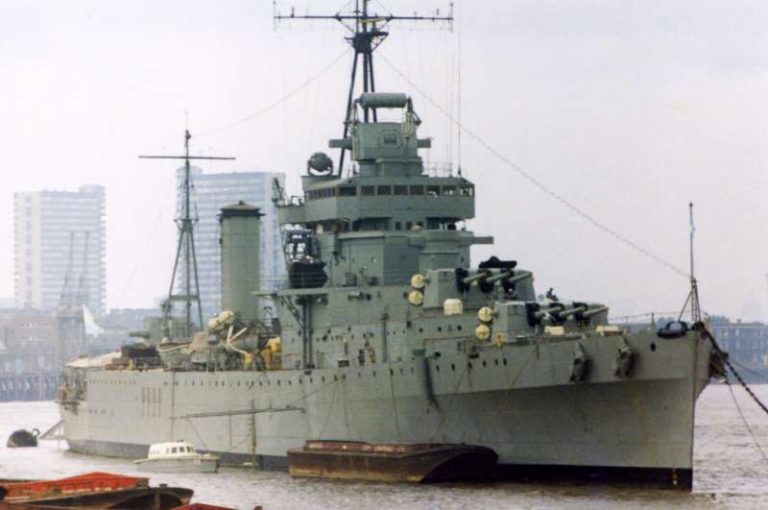
La Argentina in 1972
Another asset for the fleet was its four cruisers, by chronological order, ARA Puyreddon, V. De Mayo class (1929), and La Argentina (1936). The first was a Garibaldi-class armoured cruiser, built in Italy. Dating back from 1898 (launch) she was more than fifty years old in 1950 and used as a schoolship/coast defence vessel when it was decided to discard her, on 28.8.1954.
However the three interwar cruisers were still active, despite the fact they never really underwent any significant modernization, but La Argentina. The military value of the two Veinticinco de Mayo class cruisers was low, as they did not were significantly modernized. The “little trentos” participated in 1948 in the Argentinian squadron part of the international Antarctic expedition, unrelated however to operation Highjump. In 1951 the purchase of new Brooklyn class cruisers made them surplus. In 1955 they were active, but in 1959 they were placed in reserve and stricken in 1960 and 1961.
La Argentina was already a light cruiser with alternative training role when she was built, and she was certainly the most useful cruiser after WW2 to the Argentinian Navy. She in fact became the “ambassador” of the Marina de Argentina until her retirement in 1974 (and reserve from 1970), multiplying world tours and training cruises, sometimes carrying Isabella Peron with her, notably during her 1947 and 1948 world tours. In 1950 her catapult was removed, and her AA armament was renewed entirely to four twin and a quadruple 40 mm Bofors AA (12 in all), and a completely new electronic suite, radar and FCS. She was reclassified as permanent training ship. Her displacement also increased from 7500 in 1939 to 8300 tonnes in 1974.
Argentinian destroyers (1911-1937)
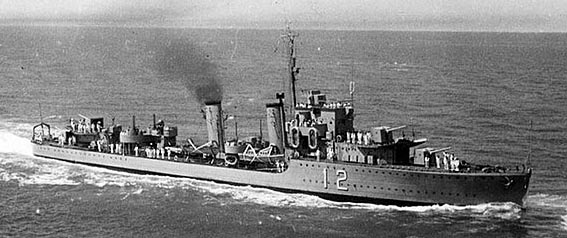
ARA Santa Cruz (T-12 from 1951) in 1948
In 1955, the Navy had 15 destroyers, at least on paper. Of this total, only the last six Buenos Aires class were valuable due to their recent service (all launched in 1937, completed before WW2). The oldest were the 890-1010 tonnes La Plata and Jujuy class (1911), reclassified as torpedo boats in WW2. In reserve in 1950, they would be discarded in 1956-57. More interesting were the tow Spanish-built Churucca class, on a based essentially on a late WW1 British admiralty flotilla leader design. The 1,522 tonnes destroyers were dating back from 1925 and after 1945 their AA was modernized: They lost a single 4.7 in gun and a single 3-in for three twin 40 mm Bofors, two between the funnels and one aft of the second funnel. In 1952 they were reclassified as Torpederos due to their tonnage (destroyer escorts). They happily stayed in service until 1959, Juan de Garay being used as training ship from 1952. Both were discarded in 1960-61.
The three Mendoza class (1929, 1570 tonnes) were modified Britush Bruce class destroyers, also reclassified as Torpederos in 1952, although Rioja and Tucuman were laid up and disarmed the same year, they continued to appear in the naval register as “active”. Mendoza was the last decomm. in 1961. Modernization is unknown, if any, probably the same kind as the Churucca class.
The Argentinian-built Buenos Aires class destroyers were certainly the most capable of the lot. Based on the British HMS Greyhound on a light tonnage (1,375 tonnes), these seven ships were modernized after the war (radar, modern FCS, new armament), but their equipment differed wildly but essentially variations of the same basic design showed by the Buenos Aires 1969: 3x 4.7 in, 4x40mm/60 Mk 3 (single) Bofors AA, 2 x 24 (178) Hedgehog ASWRL Mark 10, 2 ASW 324mm TT launchers, 4 K-Guns, 1 DCR. They were all discarded in 1971 to 1973, but apparently reclassified as torpederos and numbered T-6 to T-12, with a low tonnage compared to the modern USN destroyers acquired in 1961. In 1959 according to navypedia, they still had a single 120mm/45, two quadruple 12.7 mm/62, and a quadruple 533 TT mm TT. They were replaced by two Fletcher, four Allen M. Sumner and a single Gearing (FRAM II).
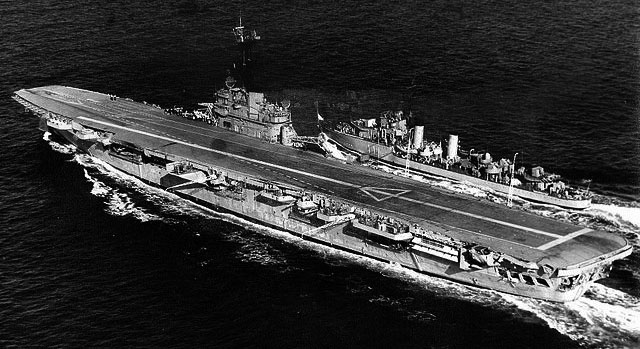
ARA Misiones (T-11) escorting the carrier Independencia in the 1950s.
Frigates (1947-48)

ARA Heroina in 1960 (src navypedia)
-ARA Hercules (River class): A single Frigate, ARA Hercules, was purchased from the Canadian navy, previously built in 1942 by Canadian Vickers and acquired on 18 april 1948. She was armed with three 105 mm, four 47 mm AA, two DCR. From 1961 she was reclassed as a Guardacostas (coastguard) and renamed Juan Batista Azopardo as a new Type 42 missile destroyer entered service with her name. She was sold for BU in 1969.
-Heroina class (Tacoma Type): The bulk of Argentinian Frigates in the 1950-70s (before replacement by the MEKO 140 corvettes) were the three ex-Tacoma class frigates acquired in 1947-48: Heroina, Sarandi and Santissima Trinidad. They were rearmed in Argentina with two local 105 mm, four 47 mm AA, and two DCR, reclassed P-32 to 34. Heroina became a meteorologcal vessel in 1961 and Santissima trinidad as a hydrographic vessel in 1962 (Comodoro Lasserre). Sold 1964, 67 and 1971.
-ARA Republica (Flower type): Rpublica (P35) was a former Flower class corvette, ex HMS Smilax launched in December 1942, acquired in December 1948. She was rearmed with one 105 mm, four 20 mm AA, and two DCR. Discarded in the 1960s.
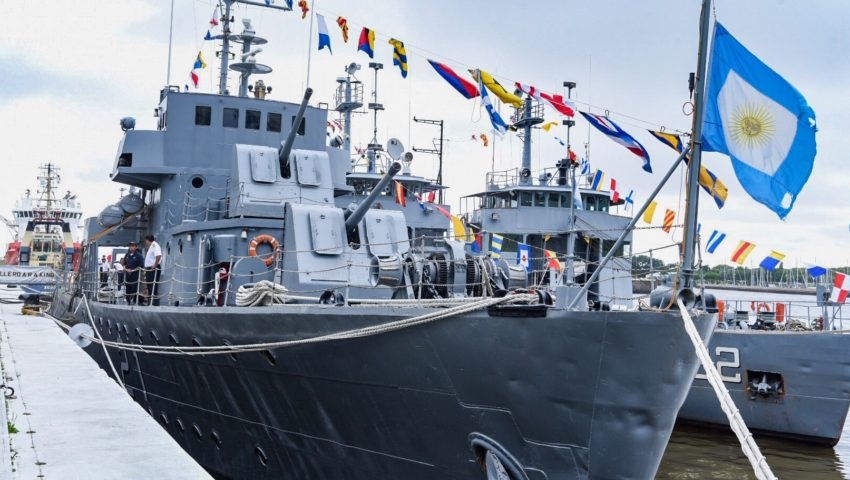
The King class were started during WW2 but in effect, completed in 1945-46 and arguably the longest Argentinian ships in service, ever. Started in 1938-40 at AFNE, Rio Santiago, they were essentially patrol frigates, a role they held until decommission in 2014-2020. Two more sister-ships were planned, Piedra Buena and Azopardo, but they were completed in 1954-1957 under a changed design as dedicated ASW frigates (see the nomenclature below). In the 1960s, the King were modernized, they had three single 105mm/45; three single 105mm/41 Bofors M45, a Decca 1226 radar and three 12.7mm/90 heavy machine guns.
Misc. Vessels
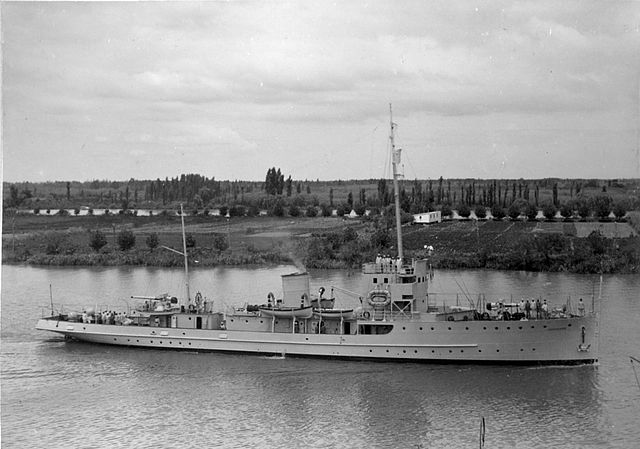
The three 1931 Santa Fe class submarines, a modified Cavallini design, served until 1959-60 when they were discarded. On 3 August 1960, ARA Salta made her symbolic 1000th dive, and both Estero and cavallini made record dives at 114 m in the south atlantic. This tells a lot about their construction quality.
As registered, they were also in service the:
-1897 training ship Presidiente Sarmiento, decomm. 1961
–Three Rosario class river gunboats (1908), decomm. 1956-59
–10 Bouchard class minesweepers (1943-44), decomm. Fournier was lost on an uncharted reef in 1949, Parker was sold to Paraguay in 1964, Comodoro Py and Bouchard in 1968 too while the rest was decomm. 1965-67. One maintained until 1982, museum ship afterwards.
Patrol ships:
-YAMANA (1943-1945/1947), decomm. 1975
-COMANDANTE GENERAL IRIGOYEN (1944-1945), decomm. 1961-1993
-COMANDANTE GENERAL ZAPIOLA (1943), decomm. 1961
The 1955 coup, “Revolución Libertadora”.
In 1955, the Navy took part in the removal of Juan Peron from power after a serie of economical failures. On 16 June 1955, 30 Argentine Navy and Air Force aircraft bombed Plaza de Mayo, where Peron’s loyalists were assembled. On 16 September, the Navy seized all key sea and local commands, although Peron still had partisans in the army, and some were retaken. The Navy demonstrated its muscle, but the naval academy of Rio Santiago and submarine based of mar del Plata had to be evacuated. Naval aviation bombed the army loyalists when trying to attack Puerto Belgrano. The cruiser 9 de julio and two submarines shelled and oil storage area for two hours, reducing it to smitherine. After this preparation, 350 Marines were landed from three frigates too this strategic point and was soon able to shell the capital. Juan Peron only resigned when the fleet arrived in Buenos Aires, with a large popular support.
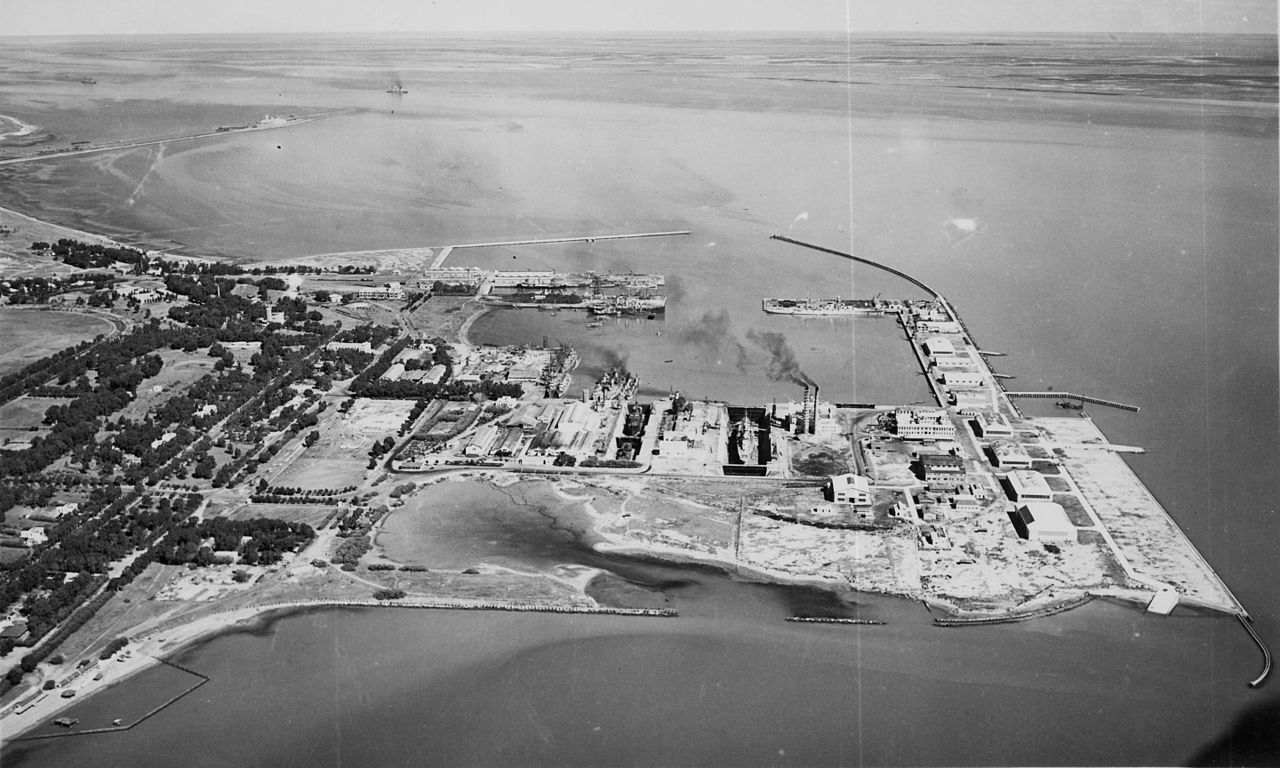
Puerto Belgrano, Argentine’s main naval base and yard, in 1943
Transition from WW2 and new naval plan
The years 1955-59 would see most of this WW2 era fleet gradually discarded, while many new acquisitions were made, notably two CVs in 1958 and 1968, and two heavy cruisers (in 1951). While trying to enforce a strict EEZ of 200 nautical miles along its coast in the 1970-80s, the Navy mostly was committed to combat “fish piracy”, arresting trawlers, like a Russian ship in 1966, which was fired on by the destroyer Santa Cruz, while three other destroyers trapped a fleet of clandestine trawlers in 1977, Soviet and Bulgarian. Also during this turbulent decade and after a bombing in 1975 of the Trinidad, terrorism became also an issue. The 1970s were also rich in new acquisitions. Following the V. De Mayo in 1968, seven destroyers were acquired (modernized Fletcher, Sumner and Gearing) added to three in 1961, and its first missile destroyers, British type 42s of which one, Santissima trinidad, was built locally at AFNE Rio Santiago.
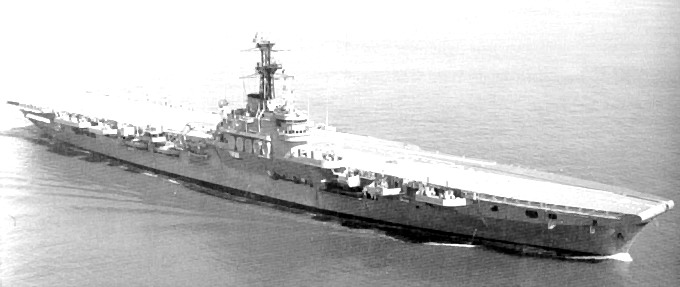
ARA Independencia
Institutions: Naval Academy and Command
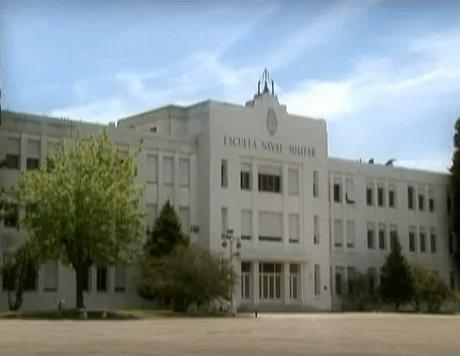
The C-in-C of the Argentinian Navy was created on October 31, 1947.
It function was precised by Law in 1966, established Naval Operations Command as an exercise from the presidence constitutional powers, with a first transitory provision transferring powers of the Secretary of State as defined in the 1958 law. On January 1, 1968, the name changed for “Comando en Jefe de la Armada.” By Decree in 1973, the interim president Raúl Alberto Lastiri created the “General Command of the Navy”, as part of the Ministry of National Defense and after the coupof March 24, 1976, the “Board of General Commanders” was created, and the C-in-C of the Armada was called “Comando en Jefe”. In 1982 for the Falklands campaign, it was Admiral Jorge Isaac Anaya which directed naval operations.
The Naval Academy (Escuela Naval Militar) The Naval Military School continued after the Nautical School created at the end of the 18th century at the initiative of General Manuel Belgrano. The Naval Military School was created in 1872, and headed by navy sergeant Major Clodomiro Urtubey, first director. This was a naval academy graduating cadets, future career officers, and its location change dover time: The General Brown’s steamer, the corvette Uruguay, with the first cadets graduated in 1879. From 1943 until today, it is located on the banks of the River Santiago, a dedicated complex (photo). The school has three curricula and upon graduation, cadets are directly incorporated in the Argentine Navy, with the rank of midshipman for job placement. Later, they can continue their professional training in higher training courses of the Navy or pursuing undergraduate/postgraduate studies, in national universites.
-Naval Command Corps: Command of operational units in naval environments, administration of justice, servces direction and administration
-Marine Corps Command Corps: Functions of the Marine Corps Echelon.
-Professional Body Intendancy: Assistance and advice on matters related to the economic and financial aspects to daily management of the Navy.
By graduating from these advanced courses, the rank of frigate lieutenant (in commission), specialist in a degree, is awarded.
The 1980s reforms
The new Galtieri junta later from 1979 pushed forward not only for more diversity, but also quantity, with the acquisition of modern Frigates of the German MEKO 360 type frigates and MEKO 140 type corvettes, plus French A69 class corvettes as well as modern Super-Etendard and Exocet missiles, or Spanish Halcon class corvette to Spain. Submarine wise, procurement mirrored the destroyers with the 1960 and 1971 acquisition of four Balao class submarines, before turning to the German expertise and the delivering of two Type 209 (1970) and four Type 1700 (1980-85). The
These bi-national construction agreements, with parts built in Argentina, were secured for local assembly, while the builder sent its expertise and procured training. It was the same from Brazil and Peru and changed little afterwards. These contracts concerned the Type 209 and TR1400 submarines, MEKO 360 Frigates, MEKO 140 Corvettes and Type 42 destroyers.
Navy also bolstered its amphibious capabilities, with the local construction of a modern Tank Landing Ship (De Soto County type) in 1968, 14 LSTs and 7 LSMs and landing crafts of various origins, plus the acquisition of the Dock Landing Ship Candido de Lasala (Ashland class) in 1970, and many smaller landing crafts. This fleet played an important role in 1982. This was completed by smaller, misc. vessels, two locally built Azopardo class patrol escorts, nine US built Higgins class MTBs, two German Lürssen TNC 45 FACs, four Babur class patrol crafts (Israel), 5 patrol tugs, 20 German-built patrol crafts (Z-28 class), and six minesweepers. This fleet really was at the peak of its strength in 1982.
The Falkland war (April – June 1982)
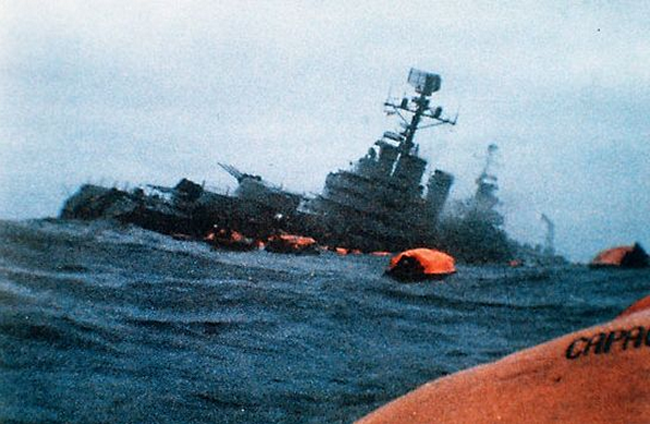
The sinking of ARA Belgrano, only cruiser kill ever by a SSN
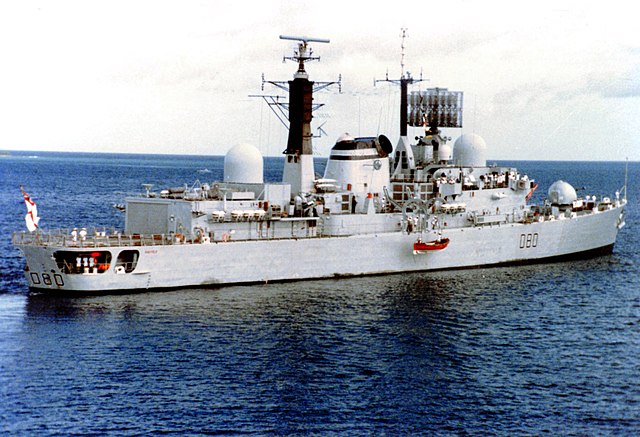
HMS Sheffield (D80), one of the two missile destroyers lost to Exocet missiles.
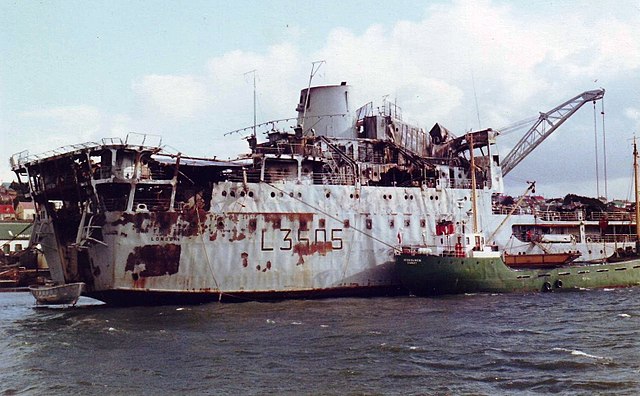
RFA Sir Tristram after the attack of Bluff Cove (Port Pleasant), 8 June 1982, performed with conventional bombs by Argentinian A-4 Skyhawk. Sir Galahad was sunk that day.
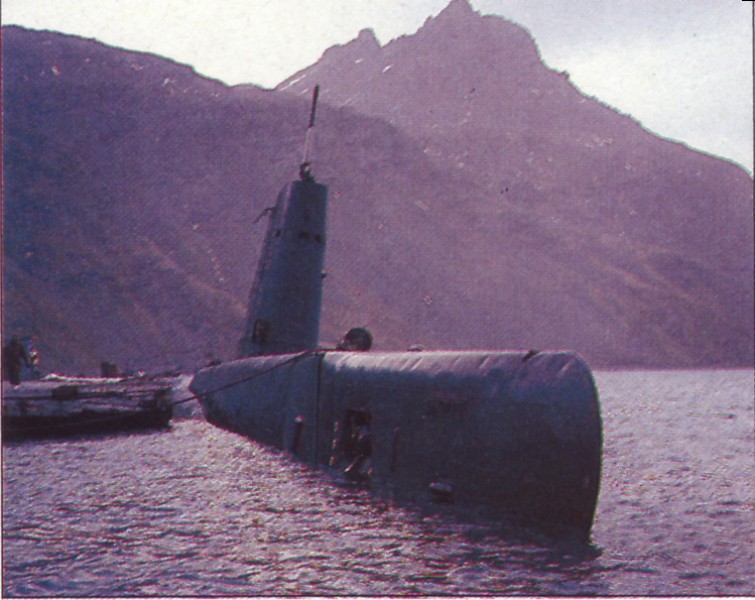
ARA Santa Fe, sunk by helicopter missiles, also a first (navsource)
In April, the fleet had a total strength of 54 ships and 31,000 personal, including 2,900 officers. Listed were:
-1 aircraft carrier with modern capabilities (V. de Mayo)
-1 heavy cruiser (another in reserve since 1978)
-9 destroyers (7 conventional, 2 missile)
-3 corvettes
-4 submarines (2 more held for spares)
-21 LSTs, LSMs, 1 TLS, 1 DLS
-30+ patrol crafts/FACs
-6 minesweepers
For political reasons, the growingly unpopular conservative government headed by General Leopoldo Galtieri decided to conduct the takeover of the contested Falklands islands (“Malvinas”), called Operation Rosario. These remote southern territories were held by the United Kingdom as well as South Georgia, and the South Sandwich Islands since the 19th century. This led to the only large scale, active wartime naval campaign between comparable naval forces of the cold war. It was full of lessons for the future, and had strong consequence both for UK politics and Argentina’s power transition. Losses of ships on both sides – Argentina: 1 cruiser, 1 submarine, 4 cargo vessels, 2 patrol boats, 1 patrol trawler; UK: 2 destroyers, 2 frigates, 1 landing ship, 1 landing craft, 1 container ship. Air operations played a very important role (as anticipated) and generated tons of reports which fed in part NATO naval policy until the end of the cold war. The conflict is presented as a British uncontested victory, as the invaded territories regained sovereignty after a relatively quick and decisive ground campaign, more contested at sea. The matter is still sensible today, nearly 40 years ago, in Argentinian medias. This will be the object of a full-fledge dedicated page in the near future.
The Argentinian Navy today
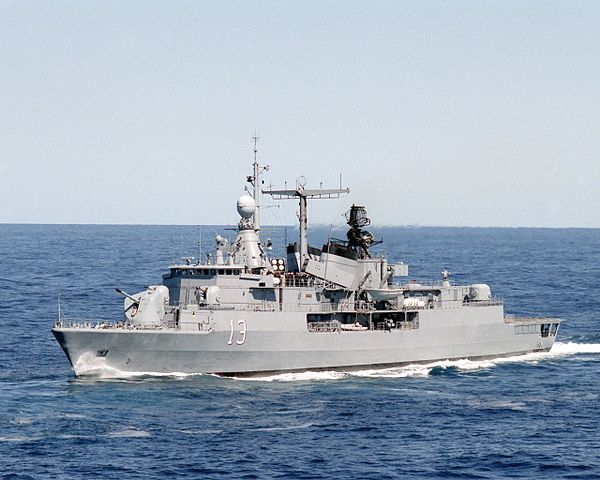
The “destroyer” ARA Sarandi (1982). Heroína is in reserve since 2009.
Political reforms and naval budget cuts
The post-Falklands era saw the military Junta fell in 1983 (National Reorganization Process since 1978) and the start of a process of democratization. The year 1982 saw the decommission of three old destroyers, 1983-84 the remainder of US WW2 modernized destroyers as well, the four old Balao-class subs, many amphibious ships and misc. vessels, in parallel to the acquisition of the new German Frigates, and German and Spanish Corvettes, while the rest of the decade saw the acquisition of four new submarines, achieving the transition.
With the end of the cold war, budget cuts and an economical situation that only grew worse in the 1990s, curtailing any plans to modernize the Argentinian Navy, which gradually lost half her tonnage, including her amphibious component and sole Aircraft carrier in 1997. The fleet held its 1980s vessels, four frigates reclassified as “destroyers” in local denomination, and nine corvettes, all ageing (the five Halcon-type were deactivated in the 2000s), plus the sole remaining, and modified type 42 destroyer, now used as a multi-purpose transport ship. The last two submarines, one of each class (Type 209 and TR 1700) are now deactivated. 10 patrol ships are also listed, from diverse origins, the oldest of all being ARA Murature, last WW2-era patrol ship of the King class. Sole recent acquisitions, the French-built Gowind class Corvettes from Naval Group in 2019, with three more planned in 2021 to 2023 (Bouchard class).
The Argentinian Marines
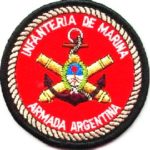 The Naval Infantry Command (Comando de la Infantería de Marina or “COIM”), is directing the Naval Infantry (Infantería de Marina de la Armada de la República Argentina or IMARA), the “Argentine marines”, amphibious warfare branch as part of the four operational commands.
The Naval Infantry Command (Comando de la Infantería de Marina or “COIM”), is directing the Naval Infantry (Infantería de Marina de la Armada de la República Argentina or IMARA), the “Argentine marines”, amphibious warfare branch as part of the four operational commands.
They trace their origins back to the Spanish Naval Infantry, taking part in many actions in South America in the 18-19th centuries and proper Argentine marines distinguished themselvces during the War of the Triple Alliance (1864-70) and, of course operation Rosario and the Falklands War. Today, it is presented by the 5th Naval Infantry Battalion, among the best Argentine combat units in the Falklands. Among other engagements, it took part was the Gulf War of 1990 and was since frequently deployed in Ops with UN peace-keeping missions.
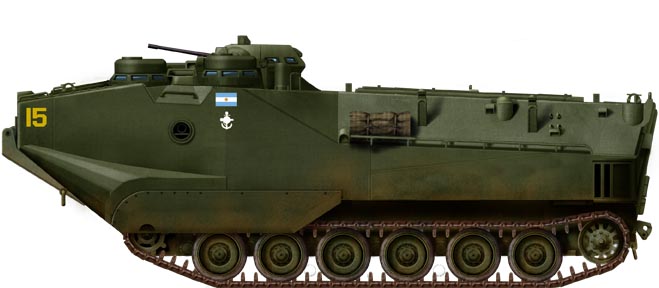
Argentine Marines LVTP-7 in 1982, Operation Rosario. Note: a shared post with tank encyclopedia will be made on Argentinian and british vehicles which participated in the Falkland war.
Read More/Src
https://en.wikipedia.org/wiki/Falklands_War
https://en.wikipedia.org/wiki/List_of_active_Argentine_Navy_ships
https://es.wikipedia.org/wiki/Anexo:Buques_de_guerra_de_Argentina
http://www.navypedia.org/ships/argentina/arg_es.htm
http://www.essa.ara.mil.ar/
Nomenclature of Argentinian Ships
ARA Independencia (1958-71)

ARA Independencia circa 1963
Launched 22 May 1944 as HMS Warrior, renamed while completed while loaned to the Royal Canadian Navy from 1946 to 1948 as HMCS Warrior, returned to UK, modenrized twice and decommissioned in 1958, this Colossus class aircraft carrier was purchased by the Argentine government in 1958. The funds were secured in part by selling to scrapyards the battleships of the Rivadavia class and cruiser Puyrredon. As she arrived in Argentina, she had been modernized in 1952-53, gaining a lattice mast, new electronics, enlarged bridge, and before transferred gained a5° angled deck, was insulated for tropical service partially air-conditioned. She entered service still in Portsmouth on 4 November 1958, while the deal has been signed in August, but only from June 1959 the first planes operated from her deck. Full commission and transfer was done in July 1959. ARA Independencia became the first Argentine aicraft carrier, still armed with twelve 40 mm Bofors guns, shortly reduced to eight, and in Augst 1963 she made her transition to jets, second-hand Argentinian F9F Panther, 24 of them. In addition to the Panther, she still carried the F4U corsair for ground attack, T-28 Trojan for training, and the TF-9J Cougar. In 1970, she was carrying six S-2A Trackers, fourteen T-28, hardly a frontline naval air group, but coherent with her training role at that point, fo the benefit of ARA Veinticinco de Mayo from 1969. Decommissioned that year she was sold on 17.03.1971. So for three years, Argentina had two aircraft carriers, one used for training.
ARA Veinticinco de Mayo (1968-97)
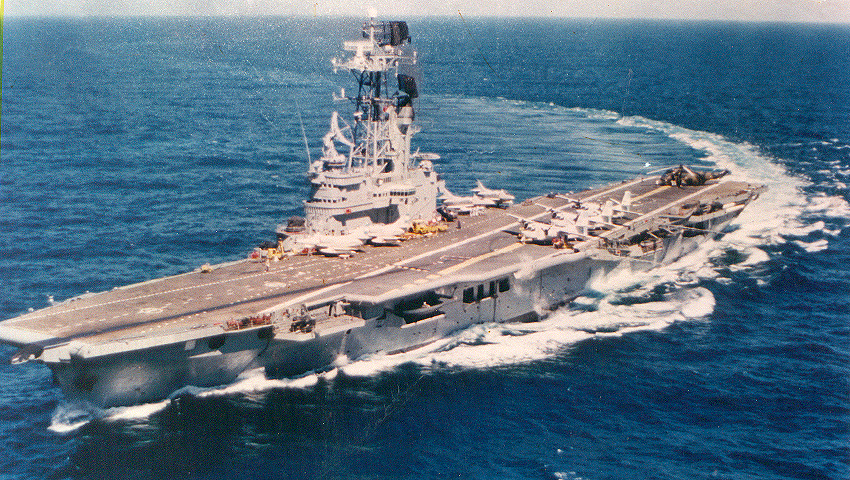
Another famous Colossus class aircraft carrier, HMS Venerable, was commissioned in 17 January 1945, but saw little action until 1947 and her decommission while negotiations went on for a transfer to the Netherlands Navy. She served from 1946 to 1968 as HNLMS Karel Doorman (see the Dutch Netherlands page) while being refitted twice, in 1955-1958 and 1965-1966. So as the Dutch navy policy changed she was no longer needed and was put on sale after her decommission in April 1968. Negociations went on until an agreement was made on 15 October 1968. ARA Veinticinco de Mayo was commissioned in March 1969.
She was planned as a replacement for the Independencia, but to operate also frontline with modern jets thanks to her comprehensive modernization. Among others, her angled deck, larger, modernized bridge and electronics, modern air surface radars (Dutch electronics, among the world’s best). However due to limited dimensions she could only operate 22 aicrafts, and was still armed with twelve 40 mm Bofors guns, a bit anachronistical in 1990…
She served as intended during the Falkland wars, but staying carefully out of harm from the fleet air arm, and subs, especially after the sinking of Belgrano. She was however no longer fully operational in 1985 and post-war trials showed she was too cramped to operate the French Dassault Super-Etendard, armed with the proven Exocet missile. The A4Q Skyhawk was an honest light bomber, but it had never has been thought as anything else as a small and cheap attack jet. Experiencing scores of engineering problems and maintenance issue, ARA Veinticinco de Mayo was no longer operable in June 1986 and was placed into reserve. While a major refit was planned in 1988, with notably a refit of her powerplant to a CODOG type, all plans were suspended in 1991 and it was planned to sold her. After an electronic refit she was still in limited commission at Rio Santiago, until 1997. Afterwards, she was dismantled gradually, and cannibalized for the NAeL Minas Gerais while the remainder was scrapped in 2000.

Conway’s profile of the V. De Mayo in 1974
V. De Mayo class Specifications 1982:
-Displacement: 15,892 tonnes standard, 19,896 tonnes FL
-Dimensions: 211.1 m oa(192 pp) x 36.9 x 7.6m (693 x 121 x 25 ft))
-Powerplant: 2 shafts Parsons Turbines, 4 adm. 3-drum boilers
-Performances: 42,000 shp, 24 knots, Fuel 3,200 tons
-Armament: 12 x 40 mm AA, 22 aircraft.
-Electronics: LW-02, SGR-103/105 radars, TACAN, CAAIS information system.
-Crew: 1250
Belgrano class cruisers (1951)

ARA General Belgrano in 1982. Despite the installation of Seacat SAMs and modern electronics she still was a WW2 conventional cruiser
In the 1950s the old cruisers of the USN were placed in selling list for brokers or potential customers, and such was the Brooklyn class while the wartime Cleveland/Baltimore were kept for much longer. The interesting deal was signed by the Argentinian government in 12.4.1951 for the delivery of two cruisers, USS Phoenix, and Boise. They were renamed in Argentinian service ARA Diecisiete de Octobre and Nueve de julio respectively. These “stock” cruisers were still in their WW2 configuration, and apart 1945 radars and FCS, had little of anything looking like a modernization, limited to partial air conditioning, more modern intercom and communicaton center. Previously before being sold they had been refitted at the Philadelphia Navy Yard, with superstructure reduced, added bulges and beam increased, mainmast derricks and catapult removed, but the hangar was kept. ARA General Belgrano (former Diecisiete de Octobre) housed two Alouette III helicopters in it. Commissioned in December 1951, both received Dutch electronics, new search radar in 1962, and two Seacat SAM were installed in 1967, making them “missile cruisers” at least in the press, which was far from the truth.

ARA Belgrano in April 1982
When the Falkland war commenced in May 1982, both had been relegated to amphibious support and gunnery training. On the 2 May 1982, Belgrano was at sea, escorted by two exocet-armed destroyers, stationed to the SW of the Falklands. Belgrano essentially was patrolling the 200 nm off the Burwood Bank when she was spotted by HMS Conqueror, a SSN arrived previously. The decision to fire was confirmed at the last moment by the PM, knowing that international consequences of such action were uncertain. After all, no ship of that importance had been sunk by a submarine since WW2. At 16h00 PM, greenlighted, she was torpedoed while sailing at 10 kts towards the mainland, 220 miles from the Falklands. She took two hits from Mk8** acoustic torpedoes, under the aft 5 in director and forward of A turret. Without power, she was dead in the water, while flooding progressed rapidly. She sank 45 minutes later, but still, 321 lives had been lost, 95% because of the both torpedo hits. The remainder 880 were rescued in 24h, all in life rafts. Nuevo de Julio was decommissioned in 1978, she served as a cannibalisation reserve for her sister ship until BU in 1983.
Brown class destroyers (1961)
Purchased from the US, five Fletcher class destroyers were acquired by the Argentinian Navy, D20 Brown and D21 spora, D2 Rosales in August 1961, still in “stock” conditions and D23 Domeck Garcia, D24 Almirante Storni on 17/08/1971, the latter with electronics upgrades. As to show the tensions around the Flaklands, ARA Almirante Storni fired warning shots and then life shots in the bow of the British oceanic research vessel Shakelton on 2 April 1976. In 1982 all but one were still “active”, but planned for decommission: The first, Espora in 1977 already, the next two after the war in 1982, and Domecq as a target in 1983. Specs as Fletcher class.
Segui class destroyers (1972)
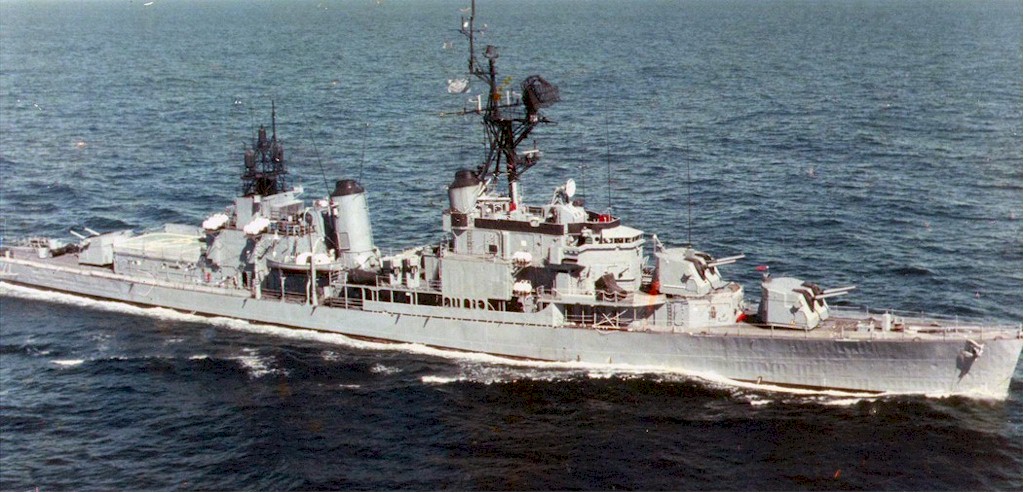
ARA Hipolito Bouchard (acquired in 1972) – credits navsource.org
Four more modern, and modernized destroyers were acquired in the 1970s from the US, of the modernized FRAM II Allen M. Sumner type. Former USS Hawk, Borie, Collett and Mansfield they became D25, 26, 29 and D31 Segui (1/7/1972), Bouchard (same), Piedra Buena (april 1974) and Espra (June 1974). Hipolito Bouchard, the first one, was just refitted preior transfer with a VDS and helicopter platform and Piedra Buena purchased for spares but activated fully in 1977, as Mansfield. In 1977-78 they were all fitted with MM38 Exocet SSM canisters, four of them. Bouchard and Piedra screened the Belgrano in 1982 and were caught off guard by the submarine attack. They chased down HMS Conqueror and made ASW grenade passes, but failed to hit her. It was discovered later that Bouchard took a torpedo hit, the third Mk48** launched on Belgrano, but it failed to detonate. Espora was decommissioned in 1978 already, the three others followed in 1983-84.
As a complementary note, a single Gearing class was acquired, ARA Comodoro Py in 1973. She was the ex-USS Perkins, and had been modernized as a FRAM II. In 1977-78 like the others she was fitted with four MM38 SSMs. She also had a SPS-40, SPQS-6 radars and SWS-23 sonar. She escorted the carrier during the Falkland war and was decommissioned in 1983.
Hercules class (missile) destroyers (1972)
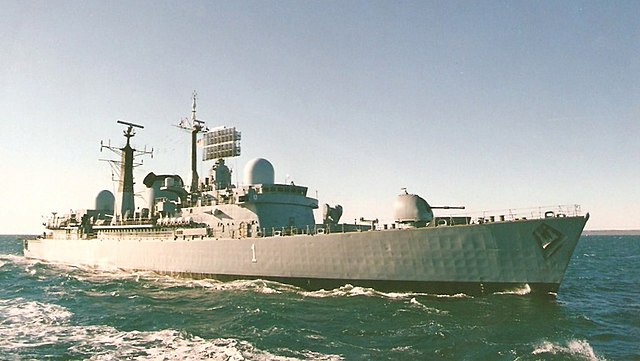
One of the most successful British missile destroyer class of the cold war, the Type 42, was negociated for acquisition by the Argentinian governement in the 1968-69 period and while the first batch was just started. In the end, two were ordered on 18 May 1970, one to be built in UK and one in Argentina: D1 Hércules at Vickers Shipbuilders Ltd, laid down in 16 June 1971, launched 24 October 1972, completed 10 May 1976 and commissioned 12 July 1976 and D2 Santísima Trinidad at AFNE, Rio Santiago. Laud down on 11 October 1971 she was completed way later, on 9 November 1974 and commissioned on 1st July 1981, so a staggering six years after her sister-ship.
However to put this in perspective this was a huge gamble to built such an advanced vessel in Argentina at that time. The numerous delays were cause by multiple technology transfers and possibly some reticence from th British Government. Another fact that delayed her completion was a 1977 terrorist attack. Hercules received two MM38 above the hangar in 1979 while it was present at completion on her sister ship.

Hercules in 1979
This went to a strange situation where in 1982 as both countries went to war, similar types destroyers were found face to face. It was not unique. When Cyprus was at war between the Turkish and Greek fleets, both sides had similar FRAM II destroyers as well. To avoid issues, both escorted the invasion force on 2 April 1982 (Operation Rosario), Trinidad making a heliborne commando attack during the preceding night. She was also the flagship of the invasion force, but in May they had been retired to serve as escorts for the carrier Veinticinco de Mayo. Electronics differed from the British Batch 1, with an ADAWS-4 data system, Type 965P, 1006, 99Q, 909 radars, Type 184M, 162M sonars. They operated the SA 319B Alouette III helicopter also, less capable than the Lynx. Laid up in 1983-86 they saw little activity afterwards. There were deprived from spare parts from UK and some negotiations took place to sell them to Turkey, but both returned in fulla active service in 1988 and they had been modernized eventually. Indeed in 2000, they were converted at astilleros ASMAR in Talcahuano in Chile, in 2000. All anti-aircraft and anti-ship missile systems were removed to carry 238 marine infantry troops, while the flight deck and hangar were enlarged to house two Sea King helicopters, capable of carrying two AM-39 Exocet each.
Brand today as “Multipurpose Transports” they are still listed as active, armed with a single 4.5-inch DP gun, 2 × 20 mm AA guns and 2×3 12.75-inch torpedo tubes.
Almirante Brown class Frigates (1981)

These well armed Frigates were a redical improvement of the fleet. Another class of six ships originally, four of them to be built in Argentina, the idea was dropped to purchased in Germany four MEKO 360 with customized features (H2 standard) and a complement of six smaller MEKO 140. The 40 mm guns are controlled by two HSA LIROD optronic/radar directors, and their construction was very modulr for future upgrades (which were done in the 2000s). As they were in construction when the conflict erupted, the delivery of their British gas turbines was embargoed (only for a time). Well-liked by their crews, these very active ships are still operating today. Among other, they participated in the 1990 gulf war.
MEKO 360 H2 Specifications:
-Displacement: 2,900 tonnes standard, 3,360 tonnes FL
-Dimensions: 125.9 oa(119 pp) x 15 x 5.8 m (413 x 49 x 19 ft))
-Powerplant: 2 shafts CODOG Olympus TM3B +2 Tyne RM-1C Gas turbines
-Performances: 51,800 bhp + 10,200 bhp, 30.5/18 knots, range 4,500 nm/18 knots
-Armament: 8 MM38 SSM, 1×8 Albatros-Aspide SAM (24), 1×127 mm OTO, 4×2 40mm Breda AA, 2×2 324 mm ASW TT, 2 Lynx Helicopter
-Electronics: SEWACO Ct Sys., HSA DA08A, ZW06 radars, Decca 1226, Signaal STIR, WM25, Krupp Atlas Sonar, DSQS-21BZ, CSEE Dagaie chaff, Breda SCLAR, Graseby G1738, ECM/ESM Sphynx/Scimitar
-Crew: 200
Drummond class corvettes (1977)
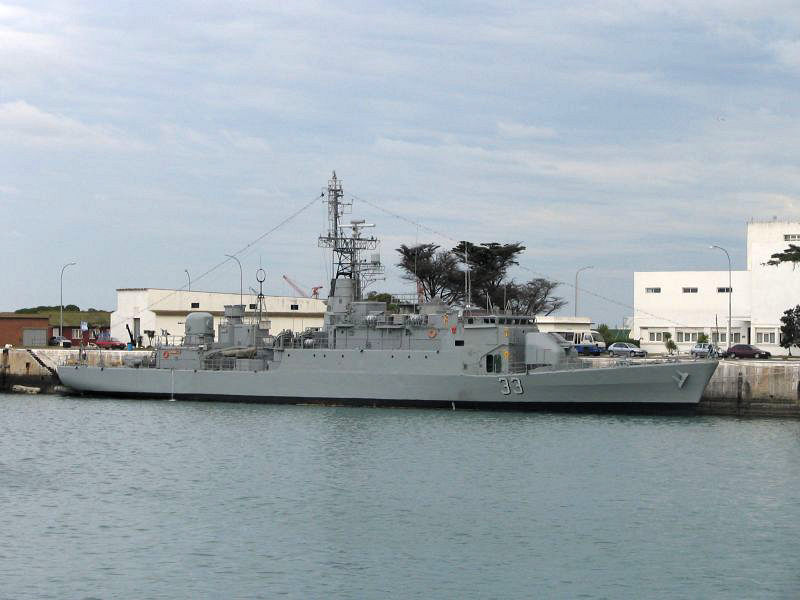
Broadly similar to the French A69 class corvettes (Estienne d’Orves class avisos), these were two ships previously ordered by South Africa (Good Hope, Transvaal) and embargoed upon delivery in 1978. They were resold to Argentina as Drummond and Guerrico, which purchased a third one, ARA Granville, launched in 1980 and delivered in 1981. Broadly similar to the French ones, but with differing electronics and armament (see notes below). They were very active during the Falklands war: Guerrico covered operations in South Georgia, and she was hit by an antitank rocket and small arms fire. In late march all three patrolled the north sector of the islands and retired on 2 april in protected waters. Pennants were F701, 702 and 703. Still active today.
class Specifications (rest as A69):
-Armament: 4 MM38 Exocet, 1x 100 mm, 1x 40, 2x 20 mm AA, 2×2 324 mm ASW TTs
-Electronics: DRBV-51A, DRBC-32C, Decca 1226, Diodon sonar
Mantilla class corvettes (1981)
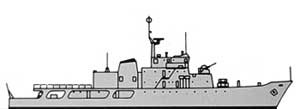
Ordered from Bazan, Spain and fitted for patrol duties with a light armament they were tailored for the harsh conditions in the souther argentinian waters. Endurance was 20 days and they carried 144 rounds for their main 40 mm AA and originally were given an Alouette III helicopter. In all, five built, ARA Mantilla, Azopardo, Thomson, Prefecto Pique, Prefecto Derbes, laid down Feb. to Nov. 1981, launched 1981-82, completed Dec. 1982 (Mantilla) to 1983. Versed to the coast guards in the 1990s.
Halcon type Specifications:
-Displacement: 767 tonnes standard, 910 tonnes FL
-Dimensions: 67 m oa x 10.5 x 4.2 m (220 x 34 x 13 ft))
-Powerplant: 2 shafts Besan-MTU 16V 956 TB91 diesels
-Performances: 9000 bhp, 21 knots, range 5000 nm/18 knots
-Armament: 1x 40 mm Breda, 2x 05 cal.HMG, 1 HB 350B Esquilo helicopter
-Electronics: Radar Decca 1226
-Crew: 33 (10 officers+ 4 cadets)
Espora class corvettes (1982)

MEKO 140 class Specifications:
-Displacement: 1,560 tonnes standard, 1,790 tonnes FL
-Dimensions: 91.2 oa(86.4 pp) x 11.1 x 3.33 m (299 x 40 x 10 ft))
-Powerplant: 2 shafts Semt-Piesltick 16 PC2 5V400 diesel
-Performances: 22,600 bhp, 27 knots, range 4,000 nm/18 knots
-Armament: 4 MM38 Exocet, 76 mm OTO, 4×40 mm Breda, 2×3 324 mm ASW TT, Sea Lynx Helicopter
-Electronics: Decca 1226 radar, DA-05/2, WM-28, LIROD Gfes, Sonar Krupp A50 80
-Crew: 93, 11 officers
Santa Fe class submarines (1960)

ARA santiago del Estero (i). Four GUPPY type Balao class subs, acquired in two waves with the same names: ARA Santa Fe (i) and Santiago del Estero (i) were acquired in July and August 1960 as GUPPY II types, with modified fins. Both were discarded in 1971 and 1972 for spares, and unnamed, although keeping their pennants, S 11 and S 12.

ARA Santa Fe (ii) in 1982. The next two were a GUPPY II for Santa Fe (ii), acquired on 07/01/1971 and GUPPY IA for Santiago del Estero (ii) acquired in January 1971. The latter was discarded in 1983. ARA Santa Fe famously took part in the Falkland war, delivering on 2 April 1982 a small force of frigmen off port Stanley, securing the approach of the main amphibious force and 600 men of the elite Marine Corps. On 25 April, Santa Fe was attacked by three British helicopters, A Westland Wasp launched from HMS Plymouth and two launched from HMS Endurance. When spotting the Santa Fe (which had no AA defense) off south Giorgia, just having delivered suplies, they approached relatively close and fired AS.12 anti-ship missiles, scoring two hits. The submarine was damaged enough to not be able to dive, she nevertheless managed to make it into Edward Cove, settling on the bottom.
Salta class submarines (1972)

These two Type 209 ordered in 1969 were based on the Greek export model with few differences (see below). They were built in sections at Howaldswerke in Kiel, to be assembled in Argentina, at AFNE. They were completed in 1974. Both were deployed during the Falkland war: Salta suffered engine troubles and returned to port after a patrol but San Luis remained fully operative, stationed at a “free fire” area north of the Falklands. She attacked British forces on the 5 May, firing torpedoes but missing, and on 10 May, for the same result. After her first unsuccessful attack she was chased off during 20 hours by British escorts, which failed to sink her. Salta was refitted from 1988 and San Luis in 1991 at Domecq Garcia NyD. Now just one is in limited service today.
Type 209 (mod. Greek order) specifications:
-Displacement: 1248 tonnes standard, 1440 tonnes sub
-Dimensions: 55.9 x 6.3 x 5.5 m (183 x 20x 18 ft))
-Electronics: FCS HSA M8, radar Thomson-CSF Calypso II, sonars Krupp Atlas CSU 3, Thomson-Sintra DUUX 2C, DUUG 1D.
-Crew: 32
Santa Cruz class submarines (1982)

The initial contract was for four Type 1700 and two TR-1400 but it was changed in 1982 for six TR1700. The first two, Santa Cruz and San Juan were built at Thyssen Norseweke in Emden, and the remainder two (two more cancelled) were to be built locally with pre-assembled sections at Astilleros Domecq Garcia, but later suspended. The first two entered service in 1984 and 1985. Only one is active today.
TR1700 class Specifications:
-Displacement: 2116 tonnes standard, 2264 tonnes sub
-Dimensions: 66 x 7.3 x 6.5 m (216 x 24 x 21 ft))
-Powerplant: 1 shaft diesel-electric, 4 MTU 16V 652, Siemens motors, 4 alternators
-Performances: 6,720 bhp (6,600+4,000 KW) for 15/25 knots, range 12,000 nm 8kts, 460 nm underwater at 6 kts.
-Armament: 6 21-in TTs, 22 torpedoes
-Electronics: Thomson-CSF radar Calypso, Sonars krupp Atlans CSU 3/4, Thomson Sintra DUUX-5.
-Crew: 26
Amphibious ships
(To come)
Miscellaneous vessels
(To Come)
-TENIENTE OLIVIERI (1981/1987)
-PUERTO ARGENTINO patrol ships (1986-1990/2015)
Books
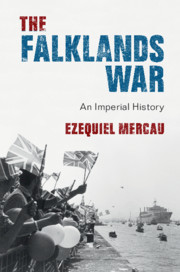



Documents
Falklands War: an analysis of UK combat injuries and survival July 2017Journal of the Royal Naval Medical Service
The Falklands/Malvinas War – 1982 – January 2017SSRN Electronic Journal
Marek Bodziany, Anna Kotasińskas: The Falklands Conflict – History and Predictions for The Future
Lessons of the Falklands, USN Department
Calhon database “The Falklands War understanding the power of context in shaping Argentine strategic decisions”, Nietzel, Scott C.

 Latest Facebook Entry -
Latest Facebook Entry -  X(Tweeter) Naval Encyclopedia's deck archive
X(Tweeter) Naval Encyclopedia's deck archive Instagram (@navalencyc)
Instagram (@navalencyc)





 French Navy
French Navy Royal Navy
Royal Navy Russian Navy
Russian Navy Armada Espanola
Armada Espanola Austrian Navy
Austrian Navy K.u.K. Kriegsmarine
K.u.K. Kriegsmarine Dansk Marine
Dansk Marine Nautiko Hellenon
Nautiko Hellenon Koninklije Marine 1870
Koninklije Marine 1870 Marinha do Brasil
Marinha do Brasil Osmanlı Donanması
Osmanlı Donanması Marina Do Peru
Marina Do Peru Marinha do Portugal
Marinha do Portugal Regia Marina 1870
Regia Marina 1870 Nihhon Kaigun 1870
Nihhon Kaigun 1870 Preußische Marine 1870
Preußische Marine 1870 Russkiy Flot 1870
Russkiy Flot 1870 Svenska marinen
Svenska marinen Søværnet
Søværnet Union Navy
Union Navy Confederate Navy
Confederate Navy Armada de Argentina
Armada de Argentina Imperial Chinese Navy
Imperial Chinese Navy Marinha do Portugal
Marinha do Portugal Mexico
Mexico Kaiserliche Marine
Kaiserliche Marine 1898 US Navy
1898 US Navy Sovietskiy Flot
Sovietskiy Flot Royal Canadian Navy
Royal Canadian Navy Royal Australian Navy
Royal Australian Navy RNZN Fleet
RNZN Fleet Chinese Navy 1937
Chinese Navy 1937 Kriegsmarine
Kriegsmarine Chilean Navy
Chilean Navy Danish Navy
Danish Navy Finnish Navy
Finnish Navy Hellenic Navy
Hellenic Navy Polish Navy
Polish Navy Romanian Navy
Romanian Navy Turkish Navy
Turkish Navy Royal Yugoslav Navy
Royal Yugoslav Navy Royal Thai Navy
Royal Thai Navy Minor Navies
Minor Navies Albania
Albania Austria
Austria Belgium
Belgium Columbia
Columbia Costa Rica
Costa Rica Cuba
Cuba Czechoslovakia
Czechoslovakia Dominican Republic
Dominican Republic Haiti
Haiti Hungary
Hungary Honduras
Honduras Estonia
Estonia Iceland
Iceland Eire
Eire Equador
Equador Iran
Iran Iraq
Iraq Latvia
Latvia Liberia
Liberia Lithuania
Lithuania Mandchukuo
Mandchukuo Morocco
Morocco Nicaragua
Nicaragua Persia
Persia San Salvador
San Salvador Sarawak
Sarawak Uruguay
Uruguay Venezuela
Venezuela Zanzibar
Zanzibar Warsaw Pact Navies
Warsaw Pact Navies Bulgaria
Bulgaria Hungary
Hungary

 Bundesmarine
Bundesmarine Dutch Navy
Dutch Navy Hellenic Navy
Hellenic Navy Marina Militare
Marina Militare Yugoslav Navy
Yugoslav Navy Chinese Navy
Chinese Navy Indian Navy
Indian Navy Indonesian Navy
Indonesian Navy JMSDF
JMSDF North Korean Navy
North Korean Navy Pakistani Navy
Pakistani Navy Philippines Navy
Philippines Navy ROKN
ROKN Rep. of Singapore Navy
Rep. of Singapore Navy Taiwanese Navy
Taiwanese Navy IDF Navy
IDF Navy Saudi Navy
Saudi Navy Royal New Zealand Navy
Royal New Zealand Navy Egyptian Navy
Egyptian Navy South African Navy
South African Navy






























 Ukrainian Navy
Ukrainian Navy dbodesign
dbodesign